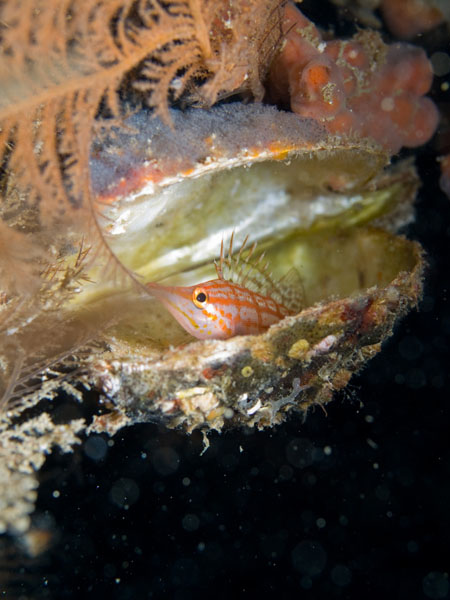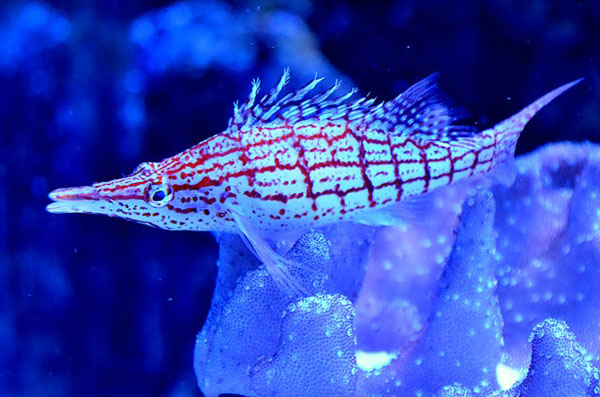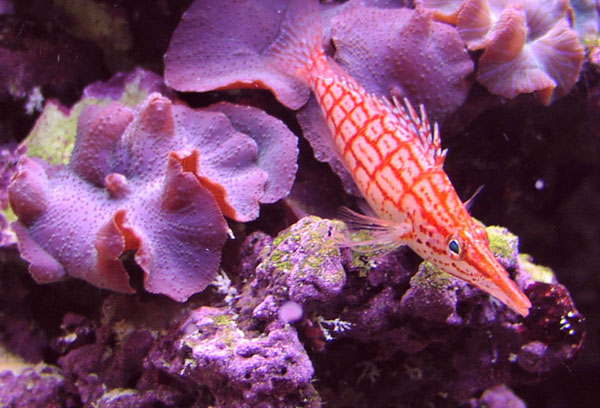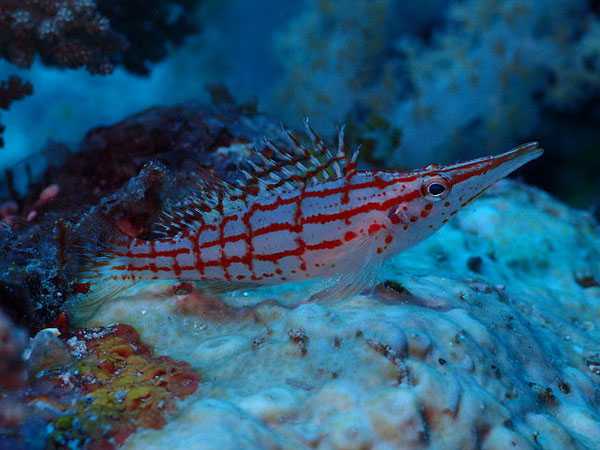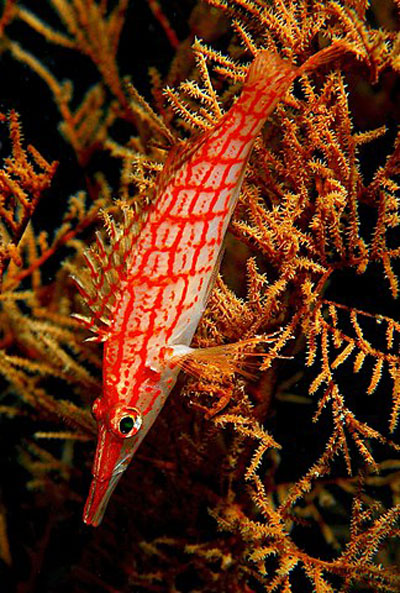[ad_1]
Longnose hawkfish (Oxycirrhites typus) make the perfect addition to any marine tank with their unique method of perching and bright colors. They’re intelligent fish with bundles of energy and lots of personality – provided you have plenty of room. Because while these saltwater hunters may not reach impressive lengths, they DO perform incredible acrobatics.
Table of Contents: Longnose Hawkfish Care
Have a particular burning question? The following links will help you navigate through different elements of longnose hawkfish care. Or you can stick around for the entire ride and learn everything there is to know about these nifty little ambush hunters.
Quick Facts
- Common Names: Longnose hawkfish, Long-nose hawkfish, Longnose hawk, Hawaiian hawk-fish, Pilikoa
- Scientific Name: Oxycirrhites typus
- Size: 5 inches (12.7cm)
- Minimum Tank Size: 40 Gallons (151L)
- Reef Safe? With Precautions
- Care or Experience Level: Easy
- Preferred Diet: Carnivore
- Original Part of the World: Indo-Pacific
Description of the Longnose Hawkfish
Members of the Cirrhitidae family, longnose hawkfish, sport the expected cirri at their dorsal rays’ ends. (It’s where the hawkfish group takes their name) Cirri resemble round spheres at the tips of the dorsal fin. They have a square tail and prominent pectoral fins that help prop them up on black corals, gorgonians, and rocks on the reef slopes’ outer edges. There they can keep an eye out for potential prey. The long, thin nose lets them poke into narrow crevices for scurrying crustaceans – if they get away.
Novice aquarists love the red plaid patterns you see on a typical longnose. Though the uninitiated wonder how such vibrant colors keep this ambush predator hidden. Red is the first color that disappears in the water column. And since these little fish hang out a depth anywhere between 10-100 meters, the red doesn’t show as they hide among the corals. It’s the perfect color choice – in the ocean or a marine aquarium.
And while you won’t see it, hawkfish lack a swim bladder. It’s a characteristic in the entire Cirrhitidae family. They can quickly move throughout the depths, with no need to decompress. Which makes them popular wild acquisitions. (Of course, divers need to make decompression stops)
Longnose Hawkfish Lifespan
In the Indian and Pacific oceans’ reefs, longnose hawkfish live anywhere from 5-7 years. With proper care and a high-quality diet, you can expect the same lifespan from your little mottled fish.
Creating the Ideal Longnose World
Longnose hawkfish haunt the Indo-Pacific, from the coast of Africa, through southern Japan, and over to the Galapagos. They perch in and around sea fans and similar corals. And if you want to keep your hawkfish happy and thriving? You need to replicate that environment as closely as possible.
If you omit perching material, your longnose will quickly succumb to stress. Even if you don’t feel up to managing sea fans or black corals, you can work in a coral skeleton or a false replica. Hawkfish need SOMETHING to perch on and hide among to feel safe and established. And if you find yourself struggling for ideas, this particular species is intelligent and adaptable enough to accept caves and rocks as substitutes. If they can comfortably perch and hide on it, they’re good.
And while you probably want to display their stunning red and white patterns to advantage, dim the lights. Longnose hawkfish have large eyes. They ARE nocturnal, so they’ll head for the hills during the day anyway, but why abuse their retinas? Look for lighting that’s kind to those shiny black eyes.
Longnose Hawkfish Tank Size
When you set out to bring a longnose hawkfish into your marine tank, you find some conflicting information. Plenty of internet resources assure you it’s okay to get away with a 40-gallon (151L) tank. Which, ostensibly, WILL work – for one fish and no additional crowding. If you want to make your longnose feel at home and comfortable (not to mention ease any stressors over territory), you need to upgrade to 100 gallons (378.5L).
Don’t just think about horizontal length, either. In pursuit of prey and as part of the spawning process (which we’ll get to in a minute), hawkfish can propel themselves UP. And they’re FAST swimmers. If you don’t consider your tank’s vertical distance, you could come home to find a hawkfish on the floor. (Never a good sign) So, while you’re at it, invest in a top-notch lid – for safety.
Are Longnose Hawkfish Reef-Safe?
Overall, you can get away with adding longnose hawkfish to an existing reef tank. However, you want to keep a couple of things tagged in the back of your mind:
- What do you have happy and established in your tank?
- Hawkfish NEED to perch – it’s in their DNA.
Sea anemones and Catalaphyllia pack a wallop! And while the longnose IS intelligent, it’s not smart enough to recognize these animals have stings powerful enough to kill them. If you’re keeping these creatures in your reef tank, consider a different fish.
And, unhappily, that perching drive CAN injure corals. It’s not intentional. The lack of the swim bladder forces hawkfish to prop up on their pectoral fins. But the constant pressure from the fins can lead to irritation or damage of clams, stony corals, AND soft corals. The larger the tank you provide – with PLENTY of perching options – the less risk to your reef tank.
Longnose Hawkfish Diet
Without a swim bladder to sustain lengthy chases through the reef environment, longnose hawkfish rely on an ambush technique. They bide their time, then make a short burst of speed to take out their prey. They have tiny, conical teeth designed for grasping. And their food of choice? In the wild, bottom-dwelling and free-swimming crustaceans.
In your saltwater tank, they’ll accept live, fresh, frozen, or freeze-dried protein sources. If you want to set up a feeder shrimp tank and cultivate brine shrimp to keep them happy, you won’t hear a complaint. They’ll also accept smaller fish – which can make things tricky in a community tank.
Longnose Hawkfish Behavior and Tank Mates
It’s tempting to want to build a saltwater aquarium around a school of longnose hawkfish. But it’s not how these fish work. They’re EXTREMELY territorial, and even risking a pair requires a lot of observation and work. You’re going to have to accept that you’ll likely only keep ONE longnose in your tank. It sounds rough, but your fish will appreciate it.
Most of the time, hawkfish tolerate their tank mates without too much trouble. If you notice your native getting restless, though, change things up. Coral reefs in the wild undergo subtle changes all the time. A simple shift in the décor may be all it takes to cut the bullying out of the equation. When things stay status quo for too long, longnoses start to get protective over their defined territories. Moving a few things around is all it takes to settle them back down.
And, of course, add longnose hawkfish into the tank LAST. With no established territory, the cunning little brain won’t pick on everyone. If you need to add a new fish down the road, pick your longnose’s sleeping hours. This is likely NOT at night! (Which many sites recommend) Nocturnal fish and night? Yeah, bad idea. Slip the newcomer in when your hawkfish is down for the count, and they won’t notice.
You want to consider fish size when stocking your community tank. The good old stand-by of “if it fits in a mouth, it’s dinner” applies to longnose hawkfish. Skip smaller species as a precaution.
And that goes for the mobile members of the invertebrate family. After all, crustaceans are their favorite diet. Unless you particularly hate your shrimp or hermit crabs (and why would you have them if you do?), you may want to consider an alternative to your clean-up crew.
Suitable tank mates include:
- Anthias
- Banggai cardinalfish
- Blue-green chromis
- Butterflyfish
- Clownfish
- Damselfish
- Dottybacks
- Dwarf angelfish
- Pseudochromids
- Regal tangs
- Wrasses
Breeding the Longnose Hawkfish
If you want to attempt breeding longnose hawkfish, it’s not impossible. It’s happened, but the fry didn’t survive to maturity. The process is slightly tricky – and not just because of the territorial nature of the fish.
Hawkfish are sequential hermaphrodites. All fish start as females. Throughout an established region, the largest fish then changes to a male. It’s a reproductive system that ensures maximum success – in the wild, anyway. In a home marine tank? Especially if you went with a smaller size? Not so much.
When you attempt to differentiate a male from a female, you have your work cut out for you. Males have black margins along the pelvic and caudal fins. However, when you’re starting with younger fish? You could be in for a rough ride. Which of your pair will switch from female to male? Will both fish SURVIVE to that point? Hard to say.
In the Pacific, longnose hawkfish spawn at sunset. The male approaches the first female with his dorsal fin erect. The pair begin a circling dance with periodic rest periods (no swim bladder, remember?). Immediately before spawning, the pair line up in parallel and swim directly UP from the coral. (Remember that vertical issue?) At the height of the arc, they turn down, flex, and release the eggs and sperm before returning to the coral. Then the male moves on to the next female in his territory to repeat the process.
Pros and Cons
Aquarists love longnose hawkfish. And why not? They’re attractive, have a unique feeding habit, and don’t require specialized care. But you still have to balance the good and bad.
Pros
- Hawkfish fall on the healthy side of the spectrum. They’re not prone to high parasite loads, either. When trouble strikes a saltwater tank, other fish show symptoms FIRST.
- Longnose adapt well. If you can’t handle corals, they’ll accept rocks or even fake replicas.
- Longnose hawkfish are sequential hermaphrodites. Without a male present in the environment, the largest fish changes sex.
Cons
- While technically reef-safe, the perching requirement of hawkfish can lead to potential problems. Anemones and Catalaphyllia have strong enough stings to kill them. They can also damage coral polyps.
- Fast swimmers, they pose a danger to hermit crabs, small species of shrimp, and smaller fish species.
- The territorial habits of longnose are STRONG. Two fish sharing a small space will result in fighting. One fish will end up harassed to the point of death, OR you’ll have to dismantle the entire tank to FIND the bully. (Yes, they hide THAT well)
For More Information
Who doesn’t want to learn more about the longnose hawkfish? You know you do.
This YouTube video gives you a glimpse into the fish in and out of coral. While not in hunting mode, you get an appreciation for that lack of the swim bladder.
Want to learn more about safe tank mates? Perfect!
Conclusions
The longnose hawkfish comes with plenty of unique adaptations. There’s the missing swimming bladder and the ambush hunting technique. Or the sequential hermaphrodism: this makes at-home breeding a bit of a challenge but livens up dinner conversation. And then you take into account the plaid pattern, working perfectly in the ocean and adding a new dimension to marine reef tanks. In total, you get one of the coolest little fish in the sea – provided you’re not a hermit crab.
References
- Donaldson, T.J., Colin, P.L., 1989. Pelagic spawning of the hawkfish Oxycirrhites typus (Cirrhitidae). Environmental Biology of Fishes. 24(4):295-300
- Donaldson, T.J., 1990. Reproductive Behavior and Social Organization of Some Pacific Hawkfishes (Cirrihitidae). Japanese Journal of Ichthyology. 36(4):439-458
- Fenner, Bob. 2012. The Longnose Hawkfish (Oxycirrhites typus). Tropical Fish Magazine. 3:89.
- Larson, E.T., 2011. Neuroendocrine Regulation in Sex-changing Fishes. Hormones and Reproduction of Vertebrates. 8:149-168
[ad_2]
Source link

